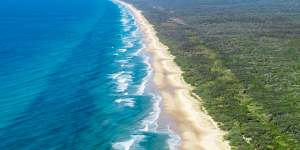Once known as Fraser Island,K’gari is the world’s largest sand island at 1840 square kilometres,made up of sand that has accumulated on the volcanic bedrock of the east Australian continental shelf.

Fraser Island is the largest sand island in the world.iStock
Research has lent further weight to the theory that the accumulation helped spur the growth of the Great Barrier Reef.
Paleoecologist Professor Patrick Moss,a supervising researcher and Head of School at the University of Queensland’s School of Earth and Environmental Sciences said the work confirmed a more exact age for K’gari.
UQ PhD candidate Daniel Ellerton conducted the experiments,getting sand samples from deep within K’gari and the nearby Cooloola sand formation on the mainland.
“When sand is buried it traps electrons within the lattice of the sand grains,and then you stimulate the grains and measure the wavelength of the light they put out,which gives you the time they’ve been buried for,” he said.
“It’s like a clock … but you have to keep them completely out of sunlight until you test them,otherwise it resets the clock.”
The research confirmed K’gari and the Cooloola formation were laid down between 1.2 million and 700,000 years ago.
It is known that sea levels fluctuated significantly at that time because of the arrival and then retreat of an ice age,which Moss said would have been able to condense the huge amounts of sediment into discrete formations.
Moss said it dovetailed with theories that the Barrier Reef started to form about half a million years ago because of a dramatic reduction in the sediment content of the surrounding water.
The formation of K’gari and Cooloola,as well as other sand islands in the region,including Mulgumpin (Moreton Island),Minjerribah (Stradbroke Island),and the sandy beaches of the Sunshine and Gold coasts locked up a lot of the sediment,which left clear water for corals to form.
“Coral reefs need two things to form:the appropriate temperature,and clear water,” he said. “If you stop all that sand swirling around,you’ll have the clearer water that allows the reef to grow.”
He stressed the theory still needed more evidence to confirm that had taken place,and said there were other places where sand could be tested in a similar way.
“There’s dune fields near Cooktown that would be very interesting to have a look at to determine their age,” he said.
“If they formed more than 700,000 years ago that would provide additional evidence that this process was taking place at the same time and helped the Reef form.”
The research has been published in the journal.